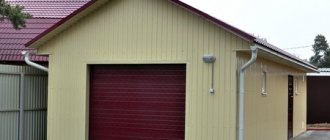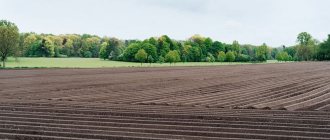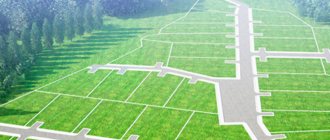Land that is acquired as a property or lease can only be used for its intended purpose. The Land Code of the Russian Federation (Article 7) distinguishes seven different categories of land: agricultural, populated areas, industrial, specially protected, forest and water resources, reserves. Within each category, its own types of use are permitted:
- Thus, agricultural land is used for gardening, vegetable gardening, farming, animal husbandry, beekeeping, fish farming, etc.;
- lands of industrial significance - for the construction of industrial, energy, transport, space and defense facilities, information communications, television and radio broadcasting, etc.
But often we have to deal with such a concept as “individual housing construction land”. What it is?
What is individual housing construction: decoding and legislative framework
The abbreviation IZhS literally means: individual residential construction.
What does individual housing construction mean in the Civil Code of the Russian Federation?
The Town Planning Code defines as an individual housing construction object a separate private household for one family (a residential building, outbuildings, attics and other household plots) within the land plot allocated for construction. A residential building must have a maximum of three floors.
How is individual housing construction deciphered in the Code of Rules?
SP 30–102-99 gives its definition:
Individual housing construction is a way of providing citizens with their own housing through individual construction. At the same time, citizens either participate in construction themselves, or it is carried out at their expense.
What land is intended for individual housing construction?
Individual residential construction is permitted on the lands of populated areas (cities, towns and villages).
- On lands of agricultural significance, it is possible to build structures and facilities necessary for growing, processing and storing agricultural products, keeping animals, working equipment, implements, etc.
- Residential buildings on agricultural lands are also built on dacha, garden and vegetable plots, but these are non-permanent buildings intended for recreation and seasonal stay. If they can still be registered as property, for example, under the dacha amnesty, then you cannot register in them.
- Another option to obtain land for individual housing construction on land not intended for this purpose is to transfer the land from the old category to a new one - “for settlement”: this can be done, for example, if the land plot is located at a distance of no more than 30 km from the city, and the site is located outside boundaries of a public easement.
Do I need to obtain a permit for individual residential construction?
Initially in the Civil Code of the Russian Federation in Art. 51 Part 9 establishes the following regulations for obtaining permits for construction, repair or reconstruction of individual housing construction projects:
- Application from an individual developer with a request to authorize construction to the authorized executive bodies (RF, constituent entities of the Russian Federation, local self-government bodies*).
- Title documents for land.
- Urban development plan *, made no later than three years ago before submitting an application for development.
- Layout of the land plot indicating the individual housing construction object on it.
- Description of the appearance of the residential housing construction* (building materials used, color design, architectural features, graphic description), if construction will be carried out within the boundaries of federal or regional historical settlements (except for the cases specified in clause 10.2 of Article 51 of the Civil Code of the Russian Federation).
According to clause 9.1 of Art. 51 developers may not provide title documents and urban planning plans, since authorized bodies request them from the relevant federal, regional, local authorities or subordinate organizations - where these documents are located.
Permission for individual housing construction is issued for a period of 10 years.
*Note:
- Local self-government bodies are local self-government bodies.
- ZU - land plot.
- OIZHS is an object of individual residential construction.
In 2020, it is not necessary to obtain permission for individual housing construction
In August 2020, Federal Law No. 372 simplified individual construction by amending the town planning code. This means that now there is no need to obtain permission for individual housing construction, but you just need to notify the authorized executive bodies about the planned construction. The innovation is based on the fact that the owner has the right to use the land within the limits of its intended purpose at his own discretion. And one of the purposes of land for settlement is individual housing construction.
Applying to the authorized bodies with a request to give permission to build a residential building is necessary only if the land plot is located on lands of other categories. In this case, it is necessary to apply for the transfer of land to the category of “land of a populated area”.
House on an individual housing construction plot
An individual housing construction house is a house built on land for individual housing construction, which is intended for year-round use. This building is being erected for one family and should not have more than three floors.
The owner of a site for individual housing construction can build any house here according to his individual design, having agreed upon it with the authorized authorities.
A special feature of a house built on an individual housing construction site is that it is assigned a permanent address.
This allows the owner and his family members, as well as all actually living citizens, to obtain permanent registration here.
After the official registration of the building, the owner of the house has the rights to receive utilities and conduct the necessary communications to the house.
Before proceeding with registration, the owner must obtain confirmation that the house is suitable for permanent residence. It must be connected to utilities: water supply, electricity, sewerage, etc. A document confirming the residential status of the house is a permit for its operation, issued by the municipal administration.
Once the building on the land is legalized and registered in the cadastral register, and the ownership rights to it are properly registered in Rosreestr, the property owner has all the grounds for registration in the house.
What is an individual residential building?
An individual residential building must comply with codes of practice 55.13330.2011, sanitary design standards SNiP and urban planning regulations.
Minimum requirements for the number of premises for a residential building:
- one living room;
- room for a kitchen or dining room;
- bath or shower;
- toilet;
- pantry or built-in wardrobes;
- boiler room with a heat generator (in the absence of central heating).
The house must have water and heat supply, electricity, sewerage, and ventilation.
Room dimensions and ceiling height:
Minimum distance of the landfill from the borders of other territories (red lines):
- streets - 5 m;
- driveways - 3 m;
- other sections of individual housing construction - 3 m.
Maximum plot sizes:
- in the urban area - 0.1 ha;
- PGT (urban-type settlements) - 0.15 hectares;
- rural areas - 0.25 hectares.
Requirements for load-bearing structures of houses and foundations
- Load-bearing structures must withstand the standard load. If the site is located in a seismic or landslide zone, the requirements become more stringent and are regulated by relevant rules.
- The foundation is designed in accordance with the characteristics of the soil, hydrogeological regime, and the presence of groundwater.
Fire safety requirements for residential buildings
Individual residential buildings must be built in accordance with the regulations on fire safety requirements (hazard class F.1).
- The distance between residential buildings must be maintained in accordance with the above regulations.
- Adjacent blocks must be separated by fire-resistant walls (fire resistance not less than REI 45).
- The structures of 3-story houses must have a third degree of fire resistance (for houses no more than 150 m2, a fourth degree of fire resistance is allowed). Houses must be equipped with optical fire detectors.
- Separate emergency exits must be provided from residential blocks.
- In the absence of central heating, it is allowed to use only factory-made gas or liquid fuel heat generators installed in premises that comply with standard safety standards SP 61.13330, SP 62.13330.
- Gas cylinder installations can only be installed outside the house. It is allowed to use a gas cylinder with a volume of no more than 50 liters indoors.
- Gas fireplaces should also only be factory-made.
- Installation of electrical equipment must be carried out using residual current devices (RCDs).
- Fire insulated cable or wires must be used for electrical wiring.
Sanitary and epidemiological requirements
In permanent premises the air temperature should be at least 20, in the kitchen and toilet - 18, in the bathroom - 24.
- The ventilation system for air purification is natural (windows, windows), mechanical and combined.
- Contaminated air is removed through ventilation ducts. Ventilation capacity: living rooms - one volume of air per hour;
- kitchen - 60 m3/hour;
- toilet - 25 m3/hour;
- other rooms, as well as in non-working mode - 0.2 volume/hour.
Construction project and passport of the individual housing construction project
The preparation of design documentation for the construction/reconstruction of residential housing construction, on the basis of Article 48 of the Civil Code of the Russian Federation, can be carried out by the developer himself (in other cases, this is done by design organizations at the request of the developer). State examination of such documentation is not carried out (Article 49 of the Civil Code).
The project includes:
- situational, topographical, general plans (with reference to the area);
- floor plans: sectional drawings of the house;
- basement, roof, foundation plans;
- documents on the estimate;
- engineering calculations;
- project passport.
A complete list of project documentation is in Appendix 8 SP 11–111-99.
The passport form and the list of materials included in it are in Appendix 7 SP 11–111-99.
Registration of individual housing construction object
To register an individual housing estate, you need to submit the following documents to the Unified State Register of Real Estate:
- cadastral passport of the land plot (to be ordered from the BTI);
- title documents for the land plot (purchase and sale agreement, transfer of ownership, etc.).
Why are individual housing construction lands expensive?
The main purpose of individual housing is to enable the owner to build and own their own housing (house, dacha, cottage).
Such lands are located within the territories of existing settlements, in developed settlements and developed areas. The demand for such land is always very high, as is the price. Let's figure out why.
Advantages of construction on individual housing construction lands:
- You can easily register a built house;
- No need to pay membership fees;
- There are no obligations for share contributions in case of repair of road surfaces and communications;
- The building is assigned a legal address and the issue of registration can be easily resolved;
- The municipal administration provides the territory with the necessary social infrastructure facilities;
- Land can be the subject of collateral (when applying for a loan or mortgage).
The disadvantages include the following:
- The size of plots is limited by regional regulations;
- The construction of the facility and its commissioning must be coordinated with the executive authorities;
- The construction period for a house is limited to three years from the date of initial registration;
- The construction of buildings must be carried out strictly in compliance with GOSTs and SNiPs;
- High tax rates;
- High price per hundred square meters.
Why are plots in DNP and SNT cheaper than individual housing construction?
First, let's define the concepts and differences between these types of lands.
DNP is a dacha non-profit association of all land owners. It is subject to state registration, and land for it is allocated by the local government administration.
There are two types of DNP lands: those located within the boundaries of a populated area and agricultural lands. Moreover, 3 years are given to develop the land after the creation of the partnership.
Most Garden Non-Profit Partnerships ( SNT ) are a “cut” of small plots ranging in size from 4 to 6 acres, on which farming and construction were carried out in the last century.
DNP is a more modern form of association. The area of their plots is, as a rule, 10-15 acres.









